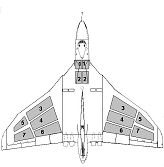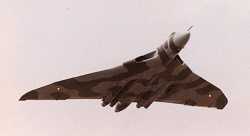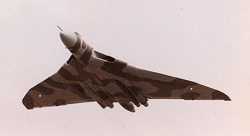|
Vulcan
Technical Specifications |
Below can be found technical data relating
to
the Avro Vulcan.
The Vulcan was, and still is, a most remarkable aircraft. Even more significant
is the fact that she was designed and built in the 1950's, making the technical
accomplishments of the design team even more astonishing.

Vulcan B1 Technical Specifications
Wingspan : 99 ft 0 in
Length : 97ft 1 in
Height : 26ft 6in
Wing Area : 3554 sq ft
Cruising Speed : Mach 0.86
Maximum Speed : Mach 0.93
Range : 2,607 nautical miles
Service Ceiling : 55,000 ft
Engines : 4 Bristol Siddeley Olympus 101, 102 or 104
Fuel Capacity: 9,250 imp gallons
|

Vulcan B2 Technical Specifications
Wingspan : 111 ft 0 in
Length : 99ft 11 in
Height : 27ft 1in
Wing Area : 3964 sq ft
Cruising Speed : Mach 0.86 (610 mph)
Maximum Speed : Mach 0.92 (625 mph)
Range : 4,000 nautical miles
Service Ceiling : 60,000 ft
Engines : 4 Bristol Siddeley Olympus 201 or 301
Fuel Capacity : 9,250 imp gallons
|

Vulcan Fuel Tanks
The fuel for the Vulcan was carried in 14 separate pressurised
tanks. (See diagram above). Although the tanks are not self sealing, they are
crash proof. Two additional fuel tanks can also be carried in the bomb bay to
increase mission distance. To give the Vulcan almost unlimited range many had an
air-to-air refuelling probe attached to the nose, thus enabling them to refuel
mid-flight. The tanks are divided into four groups, each normally feeding it own
engine. However a cross feed system was incorporated allowing fuel to be pumped
to any of the four engines from any of the four tank banks. Fully ladened, the
Vulcan was capable of carrying 9260 imperial gallons of Avtur aviation fuel in
her fuel tanks. This did does not include fuel stored in optional bomb bay fuel
tanks.
Vulcan Colour Schemes

When the Vulcan's bombing role changed from
high level to low level, so did her paint scheme.
Originally painted white to be harder to detect when cruising at high altitude (and to help reflect any heat energy from a nuclear blast) the low level role
called for a more conventional camouflage scheme to be used. Many people believe
RAF ground crew were sanctioned to paint any suitable patterns onto the mighty
delta. However, this is not the case. All Vulcan aircraft were camouflage in the
same manner. The actual Vulcan camouflage pattern can be seen in the picture
above. If you click on the picture you will see a larger version.
Vulcan Cockpit
Ever wondered what sitting in a Vulcan
cockpit
was like?
Click below to download a picture of the cockpit and to learn what many
of the switches and dials actually did.

Compare & Contrast
The Avro Vulcan was often compared to the USAF
B-52 "Stratofortress" strategic bomber.
Both aircraft were in service simultaneously.
| |
Vulcan B2 |
B-52h |
| Max Speed |
560 kts |
547 kts |
| Service Ceiling |
60,000ft |
47,700ft |
| Max Take Off Weight |
200,000lbs |
306,358lbs |
| Range (High Alt) |
4000nm |
8684nm |
| Engines |
4 x Rolls Royce Olympus 301 Turbojets |
8 x Pratt & Whitney TF33 Turbo-Fans |
| Length |
99ft 11in |
160ft 11in |
| Width |
111ft |
185ft |
| Crew |
5 |
6 |
Amazing Vulcan facts...
Each Vulcan contains 430,000 bolts, nuts and rivets.
Each Vulcan was constructed from over 100,000 different components.
The Vulcan was a fully electric aircraft. A fore-runner of the modern fly-by-wire jets used by the RAF today.
The Vulcan can weigh up to 100 tonnes fully loaded.
Each Vulcan consists of 2.5 miles of rolled sections.
It has 9,500 feet of tubing.
14 miles of electrical cable.
Contains enough sheet metal to cover 1.5 football pitches.
The Vulcan gulped 25 tonnes of air per minute through her intakes.
Each Vulcan has up to sixteen fuel tanks.
A Vulcan could carry enough fuel to power a Ford Escort motor car for 35 years at 10,000 miles a year.
The 4 Olympus jets produce as much power as 18 railway engines. They were
capable of delivering 80,000lbs of thrust.
Vulcans could outmanoeuvre F-15s in high altitude mock dogfights.
If necessary the Vulcan could be started in 27 seconds, and be airborne within 2 minutes of a squadron scramble.
The record altitude flown by a
Vulcan was 64,000ft.
 

|






